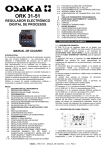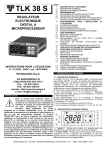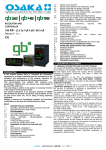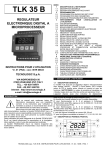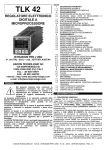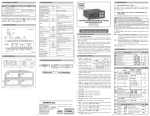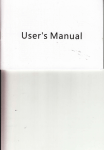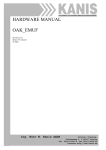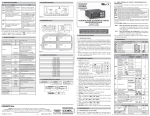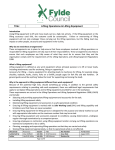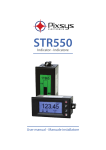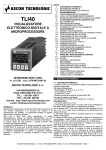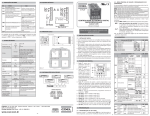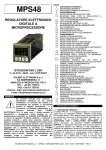Download TLK38 Temperature Controller User Manual
Transcript
TLK 38 INDEX 1 1.1 1.2 2 2.1 2.2 2.3 2.4 2.5 3 3.1 3.2 3.3 3.4 4 4.1 4.2 4.3 4.4 4.5 4.6 4.7 4.8 MICROPROCESSOR-BASED DIGITAL ELECTRONIC CONTROLLER OPERATING INSTRUCTIONS 4.9 4.10 4.11 4.12 4.13 5 6 6.1 6.2 6.3 7 7.1 7.2 7.3 Vr. 03 (ENG) - cod.: ISTR 06519 7.4 7.5 7.6 TECNOLOGIC S.p.A. VIA INDIPENDENZA 56 27029 VIGEVANO (PV) ITALY TEL.: +39 0381 69871 FAX: +39 0381 698730 internet : http:\\www.tecnologic.it e-mail: [email protected] FOREWORD: This manual contains the information necessary for the product to be installed correctly and also instructions for its maintenance and use; we therefore recommend that the utmost attention is paid to the following instructions. Though this manual has been issued with the greatest care, TECNOLOGIC S.p.A. will not take any responsibility deriving from its use. The same applies to each person or Company involved in the issuing of this manual. This document is the exclusive property of TECNOLOGIC S.p.A. which forbids any reproduction and divulgation , even in part, of the document, unless expressly authorized. TECNOLOGIC S.p.A. reserves the right to make any formal or functional changes at any moment and without any notice. INSTRUMENT DESCRIPTION GENERAL DESCRIPTION FRONT PANEL DESCRIPTION PROGRAMMING FAST PROGRAMMING OF SET POINT SELECTION OF CONTROL STATE AND PARAMETER PROGRAMMING PARAMETER PROGRAMMING LEVELS CONTROL STATES ACTIVE SET POINT SELECTION INFORMATION ON INSTALLATION AND USE PERMITTED USE MECHANICAL MOUNTING ELECTRICAL CONNECTIONS ELECTRICAL WIRING DIAGRAM FUNCTIONS MEASURING AND VISUALIZATION OUTPUTS CONFIGURATION ON/OFF CONTROL NEUTRAL ZONE ON/OFF CONTROL SINGLE ACTION PID CONTROL DOUBLE ACTION PID CONTROL AUTO-TUNING AND SELF-TUNING FUNCTIONS REACHING OF SET POINT AT CONTROLLED SPEED AND AUTOMATIC COMMUTATION BETWEEN TWO SET POINTS SOFT-START FUNCTION ALARMS OUTPUTS FUNCTIONS LOOP BREAK ALARM FUNCTION FUNCTION OF KEY “U” PARAMETERS CONFIGURATION BY KEY01 PROGRAMMABLE PARAMETERS TABLE PROBLEMS , MAINTENANCE AND GUARANTEE ERROR SIGNALLING CLEANING GUARANTEE AND REPAIRS TECHNICAL DATA ELECTRICAL DATA MECHANICAL DATA MECHANICAL DIMENSIONS, PANEL CUT-OUT AND MOUNTING FUNCTIONAL DATA MEASUREMENT RANGE TABLE INSTRUMENT ORDERING CODE 1 - INSTRUMENT DESCRIPTION 1.1 - GENERAL DESCRIPTION TLK 38 is a “single loop” digital microprocessor-based controller, with ON/OFF, Neutral Zone ON/OFF, PID single action, PID dual action (direct and reverse) control and with AUTO-TUNING FAST function, SELF-TUNING function and automatic calculation of the FUZZY OVERSHOOT CONTROL parameter for PID control. The PID control has a particular algorithm with TWO DEGREES OF FREEDOM that optimises the instrument’s features independently in the event of process disturbance and Set Point variations. The process value is visualized on 4 red displays, while the output status is indicated by 2 LED displays. The instrument is equipped with a 3 LED programmable shift indexes. The instrument provides for the storage of 4 Set Points and can have up to 2 outputs: relay type or can drive solid state relays type (SSR). Depending on the model required the input accept: C: Thermocouples temperature probes (J,K,S and TECNOLOGIC IRS Infrared sensors), mV signals (0..50/60 mV, 12..60 mV), Thermoresistances PT100. E : Thermocouples temperature probes (J,K,S and TECNOLOGIC IRS Infrared sensors), mV signals (0..50/60 mV, 12..60 mV), Thermistors PTC and NTC. I : normalized analogue signals 0/4..20 mA V : normalized analogue signals 0..1 V, 0/1..5 V, 0/2..10 V Other important available functions are: Loop-Break Alarm function, reaching of the Set Point at controlled speed, ramp and dwell TECNOLOGIC spa - TLK 38 - OPERATING INSTRUCTIONS - Vr. 03 - ISTR 06519 - PAG. 1 Pollock Industries, Inc. toll-free 1-866-665-5434 (603) 888-2467 [email protected] function, Soft-Start function, protection compressor function for neutral zone control, parameters protection on different levels. to enter into the configuration parameters menu to swap the regulator into the OFF state to swap the regulator into the automatic control state 1.2 - FRONT PANEL DESCRIPTION to activate the Auto-tuning or Self-tuning function to swap the regulator to the manual control state and 4 8 TLK 38 therefore to program the % control value using the AT 5 ST 3 “UP” and “DOWN” keys 9 Once the desired item has been selected, push key “P” to confirm. 2 Selecting "OPEr" and "ConF" gives the possibility of accessing 10 other menus containing additional parameters and more precisely : 1 11 "OPEr" - Operating parameters Menu: this normally contains the OUT1 = + OUT2 6 7 Set Point parameters but it can contain all the desired parameters 1 - Key P : This is used to access the programming parameters (see par. 2.3). "ConF" - Configuration parameters Menu: this contains all the and to confirm selection. 2 - Key DOWN : This is used to decrease the values to be set and operating parameters and the functioning configuration parameters (alarm configuration, control, input, etc.) to select the parameters. If the key is held down, the user returns to the previous programming level until he exits the programming mode. " rE G " 3 - Key UP : This is used to increase the values to be set and to select the parameters. If the key is held down, the user returns to the previous programming level until he exits the programming H o ld fo r mode. Outside the programming mode it permits visualisation of 2 s e c . the output control power. 4 - Key U : This is a key with a function programmable by par. “USrb”. It can be set to : Activate Auto-tuning and Self-tuning functions, swap the instrument to manual control, silence the alarm, change the active Set Point, deactivate control (see par. 4.12) and modify the visibility of the parameters in “ConF” menu (see par. 2.3). 5 - Led OUT1 : indicates the state of output OUT1 "O F F " 6 - Led OUT2 : indicates the state of output OUT2 7 - Led SET :It indicates access to the programming mode and parameter programming level. A U T O T U N IN G 8 - Led AT/ST : indicates that the Self-tuning function is activated S E L F T U N IN G (light on) or that Auto-tuning (flashing ) is in progress. 9 - Led – Shift index: indicates that the process value is lower than the one programmed on par. “AdE”. 10 - Led = Shift index: indicates that the process value is within "O P L O " the range [SP+AdE ... SP-AdE] 11 - Led + Shift index: indicates that the process value is higher than the one set on par. “AdE”. "ConF" "OFF" "rEG" "tunE" "OPLO" AT ST 2 - PROGRAMMING To enter the menu “ConF” select the option “ConF”, press the key “P” and the display will show “0”. At this request, enter, using keys “UP” and “DOWN”, the number reported on the last page of this manual and push key “P”. If an incorrect password is entered, the instrument exit from programming mode. If the password is correct, the display will visualise the code identifying the first group of parameters (“ ]SP “) and with keys “UP” and “DOWN” it will be possible to select the desired group of parameters. Once the desired group of parameters has been selected, the code identifying the first parameter of the selected group will be visualised by pushing the “P” key. Again using the “UP” and “DOWN” keys, it is possible to select the desired parameter and, if the key “P” is pressed, the display will alternatively show the parameter’s code and its programming value, which can be modified by using the “UP” or “DOWN” keys. Once the desired value has been programmed, push key “P” once more: the new value will be memorised and the display will show only the code of the selected parameter. By using the “UP” or “DOWN” keys, it is then possible to select a new parameter (if present) and modify it as described above. 2.2 - SELECTION OF THE CONTROL STATE AND PARAMETER To select another group of parameters, keep the “UP” or “DOWN” key pressed for approx. 2 sec., afterwards the display will return to PROGRAMMING visualise the code of the group of parameters. By pushing key "P" and holding it down for approx. 2 sec. it is Release the key and by using the “UP” and “DOWN” keys, it will be possible to enter into the main selection menu. possible to select a new group. Using the "UP" or DOWN” keys, it is then possible to roll over the To exit the programming mode, no key should be pressed for selections: approx. 20 seconds, or keep the “UP” or “DOWN” pressed until exit to enter into the operating parameters menu "OPEr" from the programming mode is obtained. 2 .1 - FAST PROGRAMMING OF THE SET POINT This procedure permits rapid programming of the active Set Point and possibly the alarm thresholds (see par 2.3) Push key “P”, then release it and the display will visualise “SP n” (where n is the number of the Set Point active at that moment) alternatively to the programmed value. To modify the value, press “UP” key to increase it or the “DOWN” key to decrease it. These keys change the value one digit at a time but if they are pressed for more than one second, the value increases or decreases rapidly and, after two seconds in the same condition, the changing speed increases in order to allow the desired value to be reached rapidly. Once the desired value has been reached, by pushing key P it is possible to exit by the fast programming mode or it is possible to visualise the alarm thresholds (see par. 2.3). To exit the fast Set programming it is necessary to push key P, after the visualisation of the last Set Point, or alternatively, if no key is pressed for approx. 15 seconds, the display will return to normal functioning automatically. TECNOLOGIC spa - TLK 38 - OPERATING INSTRUCTIONS - Vr. 03 - ISTR 06519 - PAG. 2 Pollock Industries, Inc. toll-free 1-866-665-5434 (603) 888-2467 [email protected] The programming and exit modes for the “OPEr” menu are the CONTROL OFF (OFF) – The instrument can be swapped into the same as those described for menu “ConF” with the difference that “OFF” state, i.e. the control and the relative outputs are to access the menù "OPEr" the Password is not required. deactivated. The alarm outputs are instead working normally. BUMPLESS MANUAL CONTROL (OPLO) – By means of this option it is possible to manually program the power percentage given as output by the controller by deactivating automatic control. When the instrument is swapped to manual control, the power percentage is the same as the last one supplied and can be Hold for 2 sec. modified using the “UP” and “DOWN” keys. Hold Hold for As in the case of automatic control, the programmable values Longer 2 sec. range from H100 (+100%) to C100 (-100%). To return to automatic control, select "rEG" in the selection menu. 2.5 - ACTIVE SET POINT SELECTION ATTENTION: The instrument is programmed in factory with all the This instrument permits pre-programming of up to 4 different Set parameters, to exception of the Set Point "SP1" (and 2,3,4), points (“SP1”, “SP2”, “SP3”, “SP4”) and then selection of which programmable in the menù "ConF" to the purpose to prevent wrong one must be active. The maximum number of Set points is accidental programming from non experienced consumers. determined by the par. "nSP" located in the group of parameters “ ] SP “. 2.3 - PARAMETERS PROGRAMMING LEVELS The active Set point can be selected : The menu “OPEr” normally contains the parameters used to - by parameter "SPAt" in the group of parameters “ ]SP “. program the Set Point; however it is possible to make all desired - by key “U” if par. "USrb" = CHSP parameters appear or disappear on this level, by following this - Automatically between SP1 and SP2 if a time “dur.t” (see par. 4.8) procedure: has been programmed. Enter the menu “ConF” and select the parameter to be made Set Points “SP1”, “SP2”, “SP3”, “SP4” will be visible depending on programmable or not programmable in the menu “OPEr”. the maximum number of Set Points selected on par. “nSP” and they Once the parameter has been selected, if the LED SET is switched can be programmed with a value that is between the value off, this means that the parameter is programmable only in the programmed on par. “SPLL” and the one programmed on par. menu “ConF”, if instead the LED is on, this means that the “SPHL”. parameter is also programmable in the menu “OPEr”. To modify the visibility of the parameter, push key “U” : the LED Note : in all the following examples the Set point is indicated as SET will change its state indicating the parameter accessibility level "SP", however the instrument will act according to the Set point selected as active. (on = menu ”OPEr” and “ConF”; off = menu “ConF” only). The active Set Point and the alarm thresholds will only be visible on the Set Point fast programming level (described in par. 2.1) if the 3 - INFORMATION ON INSTALLATION AND USE relative parameters are programmed to be visible (i.e. if they are 3.1 - PERMITTED USE present in the menu “OPEr”). The possible modification of these Sets, with the procedure The instrument has been projected and described in par. 2.1, is instead subordinate to what is programmed manufactured as a measuring and control device to be used according to EN61010-1 for the altitudes in par. “Edit” (contained in the group “ ]PAn “). operation until 2000 ms.The use of the instrument This parameter can be programmed as : for applications not expressly permitted by the =SE : The active Set Point can be modified while the alarm above mentioned rule must adopt all the necessary protective thresholds cannot be modified. =AE : The active Set Point cannot be modified while the alarm measures. The instrument CANNOT be used in dangerous environments (flammable or explosive) without adequate thresholds can be modified =SAE : Both the active Set Point and the alarm thresholds can be protection. The installer must ensure that EMC rules are respected, also after the instrument installation, if necessary using proper modified =SAnE : Both the active Set Point and the alarm thresholds cannot filters. Whenever a failure or a malfunction of the device may cause dangerous situations for persons, thing or animals, please be modified remember that the plant has to be equipped with additional devices which will guarantee safety. 2.4 - CONTROL STATES The controller can act in 3 different ways : automatic control (rEG), 3.2 - MECHANICAL MOUNTING control off (OFF) and manual control (OPLO). The instrument, in case 33 x 75 mm, is designed for flush-in panel The instrument is able to pass from one state to the other : - by selecting the desired state from the main selection menu suing mounting. Make a hole 29 x 71 mm and insert the instrument, fixing it with the provided special bracket. We recommend that the gasket the keyboard. - By using the key “U” on the keyboard; suitably programming par. is mounted in order to obtain the front protection degree as “USrb” (“USrb” = tunE; “USrb” = OPLO; “USrb” = OFF) it is possible declared. Avoid placing the instrument in environments with very to pass from “rEG” state to the state programmed on the parameter high humidity levels or dirt that may create condensation or introduction of conductive substances into the instrument. Ensure and vice versa. - Automatically (the instrument swaps into "rEG" state at the and of adequate ventilation to the instrument and avoid installation in containers that house devices which may overheat or which may the auto-tuning execution) When switched on, the instrument automatically reassumes the cause the instrument to function at a higher temperature than the one permitted and declared. Connect the instrument as far away as state it was in when it was last switched off. AUTOMATIC CONTROL (rEG) – Automatic control is the normal possible from sources of electromagnetic disturbances such as motors, power relays, relays, solenoid valves, etc. functioning state of the controller. During automatic control it is possible to visualize the control power 3.3 - ELECTRICAL CONNECTION on the display by pushing key “UP”. The range of the power values goes from H100 (100% of the output Carry out the electrical wiring by connecting only one wire to each power with reverse action) to C100 (100% of the output power with terminal, according to the following diagram, checking that the power supply is the same as that indicated on the instrument and direct action). that the load current absorption is no higher than the maximum electricity current permitted. As the instrument is built-in equipment TECNOLOGIC spa - TLK 38 - OPERATING INSTRUCTIONS - Vr. 03 - ISTR 06519 - PAG. 3 Pollock Industries, Inc. toll-free 1-866-665-5434 (603) 888-2467 [email protected] with permanent connection inside housing, it is not equipped with - for normalised signals in current 0..20 mA (0.20) or 4..20 mA either switches or internal devices to protect against overload of (4.20) current: the installation will include an overload protection and a - for normalised signals in tension 0..1 V (0.1), 0..5 V (0.5), 1..5 V two-phase circuit-breaker, placed as near as possible to the (1.5), 0..10 V (0.10) or 2..10 V (2.10). instrument, and located in a position that can easily be reached by - for normalised signals in tension 0..50 mV (0.50), 0..60 mV (0.60), the user and marked as instrument disconnecting device which 12..60 mV (12.60). interrupts the power supply to the equipment. It is also We recommend to switch on and off the instrument when these recommended that the supply of all the electrical circuits connected parameters are modified, in order to obtain a correct measuring. to the instrument must be protect properly, using devices (ex. For the instruments with input for temperature probes (tc, rtd) it’s fuses) proportionate to the circulating currents. It is strongly possible to select, through par. “Unit”, the unit of measurement recommended that cables with proper insulation, according to the (°C, °F) and, through par. “dP” (Pt100, PTC and NTC only) the working voltages and temperatures, be used. Furthermore, the desired resolution (0=1°; 1=0,1°). input cable of the probe has to be kept separate from line voltage Instead, with regards to the instruments with normalised analogue wiring. If the input cable of the probe is screened, it has to be input signals, it is first necessary to program the desired resolution connected to the ground with only one side. Whether the on par. “dP” (0=1; 1=0,1; 2=0,01; 3=0,001) and then, on par. instrument is 12 V version it’s recommended to use an external "SSC", the value that the instrument must visualise at the transformer TCTR, or with equivalent features, and to use only one beginning of the scale (0/4 mA, 0/12 mV, 0/1 V o 0/2 V) and, on transformer for each instrument because there is no insulation par. "FSC", the value that the instrument must visualise at the end between supply and input. We recommend that a check should be of the scale (20 mA, 50 mV, 60 mV, 5 V or 10 V). made that the parameters are those desired and that the The instrument allows for measuring calibration, which may be application functions correctly before connecting the outputs to the used to recalibrate the instrument according to application needs, actuators so as to avoid malfunctioning that may cause by using par. “OFSt” and “rot”. irregularities in the plant that could cause damage to people, things Programming par. “rot”=1,000, in par. “OFSt” it is possible to set a or animals. positive or negative offset that is simply added to the value read by Tecnologic S.p.A. and its legal representatives do not assume the probe before visualisation, which remains constant for all the any responsibility for any damage to people, things or animals measurements. deriving from violation, wrong or improper use or in any case If instead, it is desired that the offset set should not be constant for not in compliance with the instrument’s features. all the measurements, it is possible to operate the calibration on any two points. 3.4 - ELECTRICAL WIRING DIAGRAM In this case, in order to decide which values to program on par. RELAYS: 8A-AC 1 (3A-AC 3) 250 VAC “OFSt” and “rot”, the following formulae must be applied : SSR : 8 m A / 8 VD C “rot” = (D2-D1) / (M2-M1) “OFSt” = D2 - (“rot” x M2) SSR where: TLK 38 M1 =measured value 1 R ELAY D1 = visualisation value when the instrument measures M1 INPUT C NC NO C NC NO M2 =measured value 2 D2 = visualisation value when the instrument measures M2 1 2 3 4 5 6 7 8 9 10 11 12 It then follows that the instrument will visualise : TC OUT 1 OU T 2 DV = MV x “rot” + “OFSt” Pt100 where: DV = visualised value MV= measured value N TC SUPPLY PT C Example 1: It is desired that the instrument visualises the value OU T 10 V DC effectively measured at 20° but that, at 200°, it visualises a value M ax 20 mA lower than 10° (190°). 4..20 m A PASSIVE Therefore : M1=20 ; D1=20 ; M2=200 ; D2=190 (2 wires) “rot” = (190 - 20) / (200 - 20) = 0,944 e xt. “OFSt” = 190 - (0,944 x 200) = 1,2 gen. + 4..20 m A + AC TIVE + Example 2: It is desired that the instrument visualises 10° whilst the I value actually measured is 0°, but, at 500° it visualises a 50° higher 0/4..20 m A value (550°). ACTIVE Therefore : M1=0 ; D1=10 ; M2=500 ; D2=550 0..50/60 mV 0...1 V “rot” = (550 - 10) / (500 - 0) = 1,08 0/1..5 V “OFSt” = 550 - (1,08 x 500) = 10 0/2..10 V + + + + + 4 - FUNCTIONS 4.1 - MEASURING AND VISUALIZATION All the parameters referring measurements are contained in the group “]InP”. Depending on the model required the input accept: C: Thermocouples temperature probes (J,K,S and TECNOLOGIC IRS Infrared sensors), mV signals (0..50/60 mV, 12..60 mV), Thermoresistances PT100. E : Thermocouples temperature probes (J,K,S and TECNOLOGIC IRS Infrared sensors), mV signals (0..50/60 mV, 12..60 mV), Thermistors PTC and NTC. I : normalized analogue signals 0/4..20 mA V : normalized analogue signals 0..1 V, 0/1..5 V, 0/2..10 V Depending on the model, using par. “SEnS”, it’s possible to select the type of input probe, which can be : - for thermocouples J (J), K (CrAL), S (S) or for infrared sensors serie TECNOLOGIC IRTC1 with linearization J (Ir.J) or K (Ir.CA) - for thermoresistances Pt100 IEC (Pt1) or thermistors PTC KTY81-121 (Ptc) or NTC 103AT-2 (ntc) By using par. “FiL” it is possible to program time constant of the software filter for the input value measured, in order to reduce noise sensitivity (increasing the time of reading). In case of measurement error, the instrument supplies the power as programmed on par. “OPE”. This power will be calculated according to cycle time programmed for the PID controller, while for the ON/OFF controllers the cycle time is automatically considered to be equal to 20 sec. (e.g. In the event of probe error with ON/OFF control and “OPE”=50, the control output will be activated for 10 sec., then it will be deactivated for 10 sec. and so on until the measurement error remains.). By using par. “InE” it is also possible to decide the conditions of the input error, allowing the instrument to give the power programmed on par. “OPE” as output. The possibilities of par. “InE” are : = Or : the condition occurs in case of over-range or probe breakage = Ur : the condition occurs in case of under-range or probe breakage TECNOLOGIC spa - TLK 38 - OPERATING INSTRUCTIONS - Vr. 03 - ISTR 06519 - PAG. 4 Pollock Industries, Inc. toll-free 1-866-665-5434 (603) 888-2467 [email protected] This type of control can be obtained when 2 outputs are programmed respectively as 1.rEG and 2.rEG and the par. “Cont” = nr . The Neutral Zone control is used to control plants in which there is an element which causes a positive increase (ex. Heater, humidifier, etc.) and an element which causes a negative increase (ex. Cooler, de-humidifier, etc). The control functions works on the programmed outputs depending on the measurement, on the active Set Point “SP” and on the hysteresis "HSEt". The control works in the following way : it deactivates the outputs when the process value reaches the Set Point and it activates the output 1.rEG when the process value goes below value [SP HSEt], or it activates the output 2.rEG when the process value goes above [SP + HSEt]. Consequently, the element causing a positive increase has to be 4.2 - OUTPUTS CONFIGURATION The instrument’s outputs can be programmed by entering the group connected to the output programmed as 1.rEG while the element of parameters “]Out, where the relative parameters “O1F” and causing a negative increase has to be connected to the output “O2F” (depending on the number of outputs available on the programmed as 2.rEG. instrument) are located. PV The outputs can be set for the following functions : - Main control output (1.rEG) HSEt SP - Secondary control output (2.rEG) HSEt - Alarm output normally open (ALno) - Alarm output normally closed (ALnc) - Alarm output normally closed with led reverse indication (ALni) - Output deactivated (OFF) time The coupling outputs number outputs – number alarms can be 0N 0N 1.rEG made in the group referring to the alarm to the alarm (“]AL1”, OUT off off (heating) “]AL2”). 0N = OUr : the condition occurs in case of over-range or under-range or probe breakage Using par. “diSP”, located in the group “]PAn”, it is possible to set normal visualization of the display which can be the process variable (dEF), the control power (Pou), the active Set Point (SP.F) the Set Point operating when there are active ramps (SP.o) or alarm threshold AL1 or AL2 (AL1, AL2). Again in the group “]PAn” the par. “AdE” is present that defines the 3 led shift index functioning. The lighting up of the green led = indicates that the process value is within the range [SP+AdE ... SP-AdE], the lighting up of the led – indicates that the process value is lower than [SP-AdE] and the lighting up of the led + indicates that the process value is higher than [SP+AdE]. 4.3 - ON/OFF CONTROL (1.rEG) All the parameters referring to the ON/OFF control are contained in the group “]rEG”. This type of control can be obtained by programming par."Cont" = On.FS or = On.FA and works on the output programmed as 1.rEG, depending on the measure, on the active Set Point “SP”, on the functioning mode "Func” and on the hysteresis "HSEt". The instrument carries out an ON/OFF control with symmetric hysteresis if “Cont" = On.FS or with asymmetrical hysteresis if “Cont” = On.FA. PV PV SP HSEt HSEt SP time O UT 1.rE G ON ON ON OUT 1.rEG off o ff time ON ON off H EAt - On.FA ON o ff C ooL - On.FA PV off off If 2.rEG output is used to control compressor is possible to use the “Compressor Protection” function that has the meaning to avoid compressor “short cycles”. This function allows a control by time on the output 2.rEG activation, independently by the temperature control request. The protection is a “delayed after deactivation” type. This protection permits to avoid the output activation for a time programmable on par. “CPdt” (expressed in sec.); the output activation will occurs only after the elapsing of time “CPdt”. The time programmed on parameter “CPdt” is counted starting from the last output deactivation. Obviously, whether during the time delay caused by the compressor protection function, the regulator request should stop, the output activation foreseen after time “CPdt” would be erased. The function is not active programming “CPdt” =OFF. The led relative to 2.rEG output blinks during the phases of output activation delay, caused by “Compressor Protection” function. PV HSEt SP HSEt HSEt SP HSEt time O UT 1.rE G OUT 2.rEG (cooling) ON ON o ff ON off time OUT 1.rEG H EAt - On.FS ON ON off ON o ff C ooL - On.FS 4.5 - SINGLE ACTION PID CONTROL (1.rEG) All the parameters referring to PID control are contained in the group “]rEG”. The Single Action PID control can be obtained by programming par."Cont" = Pid and works on the output 1.rEG depending on the active Set Point “SP”, on the functioning mode "Func” and on the instrument’s PID algorithm with two degree of freedom. The control works in the following way : in the case of reverse PV action, or heating (“FunC”=HEAt), it deactivates the output, when SP the process value reaches [SP + HSEt] in case of symmetrical hysteresis, or [SP] in case of asymmetrical hysteresis and is then activated again when the process value goes below value [SP HSEt]. Vice versa, in case of direct action or cooling ("Func”=CooL), it deactivates the output, when the process value reaches [SP HSEt] in case of symmetrical hysteresis, or [SP] in case of O U T asymmetrical hysteresis and is activated again when the process 1 . r E G (H E a t) value goes above value [SP + HSEt]. tim e 0N tc r 1 0N 0N 0N o ff o ff o ff tc r1 tc r1 tc r 1 0N 0N o ff o ff tc r 1 tc r1 0N o ff tc r1 4.4 - NEUTRAL ZONE ON/OFF CONTROL (1.rEG - 2.rEG) In order to obtain good stability of the process variable, in the event All the parameters referring to Neutral Zone ON/OFF control are of fast processes, the cycle time “tcr1” has to have a low value with contained in the group “]rEG”. a very frequent intervention of the control output. TECNOLOGIC spa - TLK 38 - OPERATING INSTRUCTIONS - Vr. 03 - ISTR 06519 - PAG. 5 Pollock Industries, Inc. toll-free 1-866-665-5434 (603) 888-2467 [email protected] In this case use of a solid state relay (SSR) is recommended for driving the actuator. The Single Action PID control algorithm foresees the setting of the following parameters : "Pb" – Proportional Band "tcr1" – Cycle time of the output 1.rEG "Int" – Integral Time "rS" – Manual Reset (if “Int =0 only) "dEr" – Derivative Time “FuOC” - Fuzzy Overshoot Control This last parameter allows the variable overshoots at the start up of the process or at the changing of the Set Point to be avoided. Please remember that a low value on this parameter reduces the overshoot while a high value increase it. P V 2 S P 1 3 t im e 1: Value “FuOC” OK 2: Value “FuOC” too high 3: Value “FuOC” too low 4.6 - DOUBLE ACTION PID CONTROL (1.rEG - 2.rEG) All the parameters referring to PID control are contained in the group “]rEG”. The Double Action PID control is used to control plants where there is an element which causes a positive increase (ex. Heating) and an element which causes a negative increase (ex. Cooling). This type of control can be obtained when 2 outputs are programmed respectively as 1.rEG and 2.rEG and the par. “Cont” = Pid. The element causing a positive increase has to be connected to the output programmed as 1.rEG while the element causing a negative increase has to be connected to the output programmed as 2.rEG. The Double Action PID control works on the outputs 1.rEG and 2.rEG depending on the active Set Point “SP” and on the instrument’s PID algorithm with two degrees of freedom. In order to obtain good stability of the process variable, in case of fast processes, the cycle times “tcr1” and “tcr2” have to have a low value with a very frequent intervention of the control outputs. In this case use of solid state relays (SSR) to drive the actuators is recommended. The Double Action PID control algorithm needs the programming of the following parameters : "Pb" - Proportional Band "tcr1" - Cycle time of the output 1.rEG “tcr 2” - Cycle time of the output 2.rEG "Int" - Integral Time "rS" - Manual Reset (if “Int =0 only) "dEr" - Derivative Time “FuOC” - Fuzzy Overshoot Control "Prat" - Power Ratio or relation between power of the element controlled by output 2.rEG and power of the element controlled by output 1.rEG. If par. “Prat” = 0, the output 2.rEG is disabled and the control behaves exactly as a single action PID controller, through output 1.rEG. 4.7 - AUTOTUNING AND SELFTUNING FUNCTIONS All the parameters referring to the AUTO-TUNING and SELF-TUNING functions are contained in the group “]rEG”. The AUTO-TUNING and SELF-TUNING functions permit the automatic tuning of the PID controller. The AUTO-TUNING function permits the calculation of thePID parameters by means of a FAST type tuning cycle and, at the end of this operation, the parameters are stored into the instrument’s memory and remain constant during control. The SELF-TUNING function (rule based "TUNE-IN") instead allows control monitoring and the continuous calculation of the parameters during control. Both functions automatically calculate the following parameters : "Pb" - Proportional Band "tcr1" - Cycle time of the output 1rEG "Int" - Integral Time "dEr" - Derivative Time “FuOC” - Fuzzy Overshoot Control and, for the Double Action PID control, also : “tcr 2” - Cycle time of the output 2rEG "Prat" - Power Ratio P 2.rEG/ P 1.rEG To activate the AUTO-TUNING function proceed as follows : 1) Program and activate the desired Set Point. 2) Program par. "Cont" =Pid. 3) Program par. "Func" according to the process to be controlled through output 1rEG. 4) Program an output as 2.rEG if the instrument controls a plant with double action 5) Program par. "Auto" as: - "1” – if auto-tuning is desired automatically, each time the instrument is switched on, on the condition that the process value is lower (with “Func” =HEAt) than [SP- |SP/2|] or higher (with “Func” =CooL) than [SP+ |SP/2|]. - "2" – if auto-tuning is desired automatically, the next time the instrument is switched on, on the condition that the process value is lower (with “Func” =HEAt) than [SP- |SP/2|] or higher (with “Func” =CooL) than [SP+ |SP/2|], and once the tuning is finished, the par. “Auto” is automatically swapped to the OFF state - "3" - if manual auto-tuning is desired, by selecting par. “tunE” in the main menu or by correctly programming key “U” as “USrb” = tunE. The Autotuning will start at the condition that the process value is lower (with “Func” =HEAt) than [SP- |SP/5|] or higher (with “Func” =CooL) than [SP+ |SP/5|]. - "4" - if it’s desired to activate the autotuning automatically to every change of Set Point, or at the end of programmed Soft-Start cycle. The Autotuning will start at the condition that the process value is lower (with “Func” =HEAt) than [SP- |SP/5|] or higher (with “Func” =CooL) than [SP+ |SP/5|]. 6) Exit from the parameter programming. 7) Connect the instrument to the controlled plant. 8) Activate the Auto-tuning by switch off and turn on the instrument if “Auto”=1 or 2 , or by selecting par. “tunE” in the main menu (or by correctly programming key “U” ). At this point the Auto-tuning function is activated and is indicated by the flashing led AT/ST. The regulator carries out several operations on the connected plant in order to calculate the most suitable PID parameters. If, at the Auto-tuning start, the condition for the lower or higher process value is not found the display will show “ErAt” and the instrument will be swapped to normal control conditions according to the previously programmed parameters. To make the error “ErAt” disappear, press key P. The Auto-tuning cycle duration has been limited to 12 hours maximum. If Auto-tuning is not completed within 12 hours, the instrument will show "noAt" on the display. In case of probe error, the instrument automatically stops the cycle in progress. The values calculated by Auto-tuning are automatically stored in the instrument’s memory at the end of the correct PID parameters tuning. Note : The instrument is already programmed in our factory to carry out auto-tuning at first instrument switch on ("Auto" = 2). To activate the SELF-TUNING function proceed as follows 1) Program and activate the desired Set Point. 2) Program par. "Cont" =Pid. 3) Program par. "Func" according to the process to be controlled through output 1.rEG. 4) Program an output as 2.rEG if the instrument controls a dual-action plant TECNOLOGIC spa - TLK 38 - OPERATING INSTRUCTIONS - Vr. 03 - ISTR 06519 - PAG. 6 Pollock Industries, Inc. toll-free 1-866-665-5434 (603) 888-2467 [email protected] 5) Program par. "SELF" = yES 6) Exit from the parameter programming. 7) Connect the instrument to the controlled plant. 8) Activate Self-tuning selecting par. “tunE” in the main menu (or by correctly programming key “U”). When the Self-tuning function is active, the led AT/ST is permanently lit up and all the PID parameters ("Pb", "Int", "dEr", etc.) are no longer visualized. Note : It’s always preferable tuning the instrument using the Autotuning and to activate the Selftuning after because the tuning through Selftuning is more slow. To stop the Auto-tuning cycle or deactivate the Self-tuning function select one of the control types : "rEG", "OPLO" or "OFF" from the menu “SEL”. If the instrument is switched off during Auto-tuning or with the Self-tuning function activated, these functions will remain activated the next time it is switched on. 4.8 - REACHING OF THE SET POINT AT CONTROLLED SPEED AND AUTOMATIC SWITCHING BETWEEN TWO SET POINTS (RAMPS AND DWELL TIME) All the parameters referring to the ramps functioning are contained in the group “]rEG”. It is possible to reach the set point in a predetermined time (in any case longer than the time the plant would naturally need). This could be useful in those processes (heating or chemical treatments, etc.) where the set point has to be reached gradually, in a predetermined time. Once the instrument has reached the first Set Point (SP1) it is possible to have automatic switching to the second Set Point (SP2) after a set time, thus obtaining a simple automatic process cycle. These functions are available for all the programmable controls (PID single and double action, ON/OFF and Neutral Zone ON/OFF). The function is determined by the following parameters : "SLor" - Gradient of first ramp expressed in unit/minute "SLoF" - Gradient of second ramp expressed in unit/minute. "dur.t" - Dwell time of Set Point “SP1” before automatic switching to Set Point “SP2” (expressed in hrs. and min.). The functions are deactivated when the relative parameters are = InF. If is desired only one ramp (ex. to reach “SP1”) it is enough to program on the par. "SLor" the desired value. The ramp "SLor" it will always active at power on and when the Active Set Point value is changed. PV [ U n it ] SLor SP1 S Lor SP1 change S P 1 V a lu e cycle has been completed. It is therefore recommended that Auto-tuning be started avoiding activating the ramp function and, once the tuning is finished, deactivate Auto-tuning (“Auto” = OFF), program the desired ramp and, if it automatic tuning is desired, enable the Self-tuning function. 4.9 - SOFT-START FUNCTION All the parameters referring to the Soft -Start functioning are contained in the group “]rEG”. The Soft-Start function only works through PID control and allows the limitation of control power when the instrument is switched on, for a programmable period of time. This is useful when the actuator, driven by the instrument, may be damaged excess power supplied when the application is not yet in the normal rating. (ex. for certain heating elements). The function depends on the following parameters : “St.P” - Soft-Start power “SSt” - Soft-Start time (expressed in hh.mm) “HSEt” - End Soft Start cycle threshold If both parameters are programmed with values other than OFF, when switched on the instrument gives an output power as programmed on par. “St.P” for the time programmed on par. “SSt” or when is reached the absolute value programmed at par. “HSEt”. Practically, the instrument works in manual condition and switches to automatic control at the elapsing of time “SSt” or when is reached the absolute value programmed at par. “HSEt”. To disable the Soft-Start function simply program par. “SSt” = OFF. Whenever, a measurement errors occurs during the Soft-Start execution, the function is interrupted and the instrument gives an output power as programmed on par. “OPE”. If the measurement is restored, the Soft-Start is still deactivated. If it’s desired to activate the Autotuning with Soft-Start set par. “Auto”=4. The Autotuning will start automatically at the end of programmed Soft-Start cycle at the condition that the process value is lower (with “Func” =HEAt) than [SP- |SP/5|] or higher (with “Func” =CooL) than [SP+ |SP/5|]. 4.10 - ALARMS OUTPUTS FUNCTIONS (AL1, AL2) The alarms (AL1, AL2) are depending on the process value and before to set his functioning it’s necessary to establish to which output the alarm has to correspond to. First of all it’s necessary to configure, in the parameters group “]Out”, the parameters relative to the outputs required as alarm (“O1F” , “O2F”) programming the parameter relative to the desired output as follows : = ALno if the alarm output has to be ON when the alarm is active, while it’s OFF when the alarm is not active = ALnc if the alarm output has to be ON when the alarm is not active, while it’s OFF when the alarm is active = ALni if the alarm output has to be ON when the alarm is not active, while it is OFF when the alarm is active but with reverse led indication (led ON= alarm OFF). t im e [ m in . ] If it is desired an automatic cycle from the power on instead it is necessary to program the par. "nSP" = 2, to program the two Set Point values "SP1" and "SP2" and naturally to program the par. "SLor", "dur.t" and "SLoF" with the desired values. In this case at the end of the cycle all the ramps won't be more active. Note: In all the examples that follow is made reference to the alarm AL1. Naturally the operation of the other alarms results analogous. Have now access at the group “]AL1”, and program on “OAL1” , to which output the alarm signal has to be sent. The alarm functioning is instead defined by parameters : "AL1t " - ALARM TYPE "Ab1" - ALARM CONFIGURATION PV [U n it] “AL1” - ALARM THRESHOLD d u r .t SP1 “AL1L” - LOW ALARM THRESHOLD (for band alarm) SLoF SLor MINIMUM SET OF AL1 ALARM THRESHOLD (for low or SP2 alarm) “AL1H” - HIGH ALARM THRESHOLD (for band alarm) MAXIMUM SET OF AL1 ALARM THRESHOLD (for low or AUTO t im e [ m in .] change alarm) S et “HAL1” - ALARM HYSTERESIS Examples with starts from values lower than SP and with “AL1d” - ALARM ACTIVATION DELAY (in sec.) decreasing of SP. Note: In case of PID control, if Auto-tuning is desired whilst the "AL1i" - ALARM BEHAVIOUR IN THE EVENT ramp function is active, this will not be carried out until the tuning MEASUREMENT ERROR TECNOLOGIC spa - TLK 38 - OPERATING INSTRUCTIONS - Vr. 03 - ISTR 06519 - PAG. 7 Pollock Industries, Inc. toll-free 1-866-665-5434 (603) 888-2467 [email protected] par. OR high OR high OF "AL1t" – ALARM TYPE : the alarm output can behave in six different ways. LoAb = ABSOLUTE LOW ALARM: The alarm is activated when the process value goes below the alarm threshold set on parameter "AL1” and will be deactivated when it goes above the value [AL1+HAL1]. With this mode is possible to program the minimum and the maximum set of “AL1” by “AL1L” and “AL1H” parameters. HiAb = ABSOLUTE HIGH ALARM: The alarm is activated when the process value goes higher than the alarm threshold set on parameter "AL1" and will be deactivated when it goes below the value [AL1 - HAL1]. With this mode is possible to program the minimum and the maximum set of “AL1” by “AL1L” and “AL1H” parameters. The number to be set, which will correspond to the function desired, is obtained by adding the values reported in the following descriptions : ALARM BEHAVIOUR AT SWITCH ON: the alarm output may behave in two different ways, depending on the value added to par. “Ab1”. +0 = NORMAL BEHAVIOUR: The alarm is always activated when there are alarm conditions. +1 = ALARM NOT ACTIVATED AT SWITCH ON: If, when switched on, the instrument is in alarm condition, the alarm is not activated. It will be activated only when the process value is in non-alarm conditions and then back in alarm conditions. PV AL1 PV PV tim e HAL1 HAL1 +0 AL1 o ff ON off ON off time off OUT AL1 ON ON off LoAb off time off HiAb LodE = DEVIATION LOW ALARM: The alarm is activated when the process value goes below the value [SP + AL1] and will be deactivated when it goes above the value [SP + AL1 + HAL1]. With this mode is possible to program the minimum and the maximum set of “AL1” by “AL1L” and “AL1H” parameters. HidE = DEVIATION HIGH ALARM: The alarm is activated when the process value goes above the value [SP + AL1] and will be deactivated when it goes below the value [SP + AL1 - HAL1]. With this mode is possible to program the minimum and the maximum set of “AL1” by “AL1L” and “AL1H” parameters. PV PV SP O N ON ON off off HAL1 SP time OUT AL1 off ON ON off off LodE HAL1 ON off ON off tim e time O N off time off HAL1 AL1H SP - AL1L OUT AL1 LHAb HAL1 ON ON off off o ff +0 time off LHdE "Ab1" - ALARM CONFIGURATION: This parameter can assume a value between 0 and 31. +4 o ff O N A b1 PV AL1L OUT AL1 P V HidE HAL1 o ff AL1 LHAb = ABSOLUTE BAND ALARM: The alarm is activated when the process value goes under the alarm threshold set on parameter "AL1L" or goes higher than the alarm threshold set on parameter "AL1H" and will be deactivated when it goes below the value [AL1H - HAL1] or when it goes above the value [AL1L + HAL1]. LHdE = DEVIATION BAND ALARM: The alarm is activated when the process value goes below the value [SP + AL1L] or goes above than the value [SP + AL1H] and will be deactivated when it goes below the value [SP + AL1H - HAL1] or when it goes above the value [SP + AL1L + HAL1]. PV AL1H o ff exemple with absolute low alarm ALARM DELAY: the alarm output may behave in two different ways depending on the value added to par. “Ab1”. +0 = ALARM NOT DELAYED: The alarm is immediately activated when the alarm condition occurs. +2 = ALARM DELAYED: When the alarm condition occurs, delay counting begins, as programmed on par. “AL1d” (expressed in sec.) and the alarm will be activated only after the elapsing of that time. ALARM LATCH: : the alarm output may behave in two different ways depending on the value added to par. “Ab1”. + 0 = ALARM NOT LATCHED: The alarm remains active in alarm conditions only. + 4 = ALARM LATCHED: The alarm is active in alarm conditions and remains active even when these conditions no longer exist, until the correctly programmed key “U”, (“USrb”=Aac) has been pushed. HAL1 AL1 -AL1 OUT AL1 o ff Ab1 +1 OUT AL1 O N O N AL1 o ff exemple with absolute high alarm ALARM AKNOWLEDGEMENT: : the alarm output may behave in two different ways depending on the value added to par. “Ab1”. + 0 = ALARM NOT AKNOWLEDGED: The alarm always remains active in alarm conditions. + 8 = ALARM AKNOWLEDGED: The alarm is active in alarm conditions and can be deactivated by key “U” if properly programmed (“USrb”=ASi), and also if alarm conditions still exist. ALARM BEHAVIOUR AT SET POINT CHANGE (DEVIATION ALARMS ONLY): the alarm output may behave in two different ways, depending on the value added to par. “Ab1”. +0 = NORMAL BEHAVIOUR: The alarm is always activated when there are alarm conditions. +16 = ALARM NOT ACTIVATED AT SET POINT CHANGE: If, when Set Point change, the instrument is in alarm condition, the alarm is not activated. It will be activated only when the process value is in non-alarm conditions and then back in alarm conditions. "AL1i" - ALARM ACTIVATION IN CASE OF MEASUREMENT ERROR: This allows one to establish how the alarm have behave in the event of a measurement error (yES=alarm active; no=alarm deactivated). TECNOLOGIC spa - TLK 38 - OPERATING INSTRUCTIONS - Vr. 03 - ISTR 06519 - PAG. 8 Pollock Industries, Inc. toll-free 1-866-665-5434 (603) 888-2467 [email protected] 4.11 - LOOP BREAK ALARM FUNCTION All the parameters referring to the Loop Break alarm function are contained in the group “]LbA”. The Loop Break alarm is available on all the instruments, which intervenes when, for any reason (short-circuit of a thermocouple, thermocouple inversion, load interruption), the loop control is interrupted. First of all, it is necessary to establish to which output the alarm has to correspond. To do this it is necessary to set the parameter relative to the output to be used (“O1F” , “O2F”) in the group “]Out”, programming the parameter as : = ALno if the alarm output has to be ON when the alarm is active while it is OFF when the alarm is not active. = ALnc if the alarm output has to be ON when the alarm is not active while it is OFF when the alarm is active. = ALni if the alarm output has to be ON when the alarm is not active, while it is OFF when the alarm is active but with reverse led indication (led ON= alarm OFF). Enter group “]LbA” and program which output the alarm signal has to be addressed to on par. “OLbA”,. The Loop Break alarm is activated if the output power remains at the 100% of the value for the time programmed on par. "LbAt" (expressed in sec.). To avoid false alarms, the value of this parameter has to be set considering the time the plant takes to reach the Set point when the measured value is a long distance from it (for example at the plant start-up). On alarm intervention, the instrument visualizes the message “LbA” and behaves as in the case of a measurement error giving a power output as programmed on par. “OPE” (programmable in the group “]InP”). To restore normal functioning after the alarm, select the control mode “OFF” and then re-program the automatic control (“rEG”) after checking the correct functioning of probe and actuator. To exclude the Loop Break alarm, set “OLbA” = OFF. 4.12 - FUNCTIONING OF KEY “U” The function of key “U” can be set through par. “USrb” contained in the group ““]PAn”. The parameter can be programmed as : = noF : no function = tunE : Pushing the key for 1 sec. at least, it is possible to activate/deactivate Auto-tuning or Self-tuning = OPLO : Pushing the key for 1 sec. at least, it is possible to swap from automatic control (rEG) to manual one (OPLO) and vice versa. = Aac : Pushing the key for 1 sec. at least, it is possible to acknowledge the alarm. (see par. 4.10) = ASi : Pushing the key for 1 sec. at least, it is possible to acknowledge an active alarm (see par. 4.10) = CHSP : Pushing the key for 1 sec. at least, it is possible to select one of the 4 pre-programmed Set Points on rotation. = OFF : Pushing the key for 1 sec. at least, it is possible to swap from automatic control (rEG) to OFF control (OFF) and vice versa. device while if it results green blinking or red blinking this means that it has not been loaded any valid configuration on the device . 5) press the button placed on the device. 6) observe the indication led : after having pressed the button, the led becomes red and therefore, at the end of the data transfer, it becomes green. 7) now it is possible to disconnect the device. To transfer the configuration loaded on the device onto an instrument of the same family (DOWNLOAD), it is necessary to proceed in the following way: 1) position both dip switch of KEY 01 in the ON mode. 2) connect the device to an instrument TLK having the same features of the one from which has been downloaded the desired configuration, plugging the special connector. 3) verify that the instrument or the device are supplied 4) observe the indication led on the device KEY 01: it has to result green, because if the led results green blinking or red blinking, this means that on the device it has not been downloaded any valid configuration and therefore it’s useless to continue. 5) if the les results green, press the button placed on the device. 6) observe the indication led : after having pressed the button, the led becomes red and therefore, at the end of the data transfer, it becomes green. 7) now it is possible to disconnect the device. Instrument supplied and device not supplied SUPPLY Instrument supplied from the device SUPPLY ADAPTER 12 VDC AC SUPPLY For additional info, please have a look at the KEY01 instruction manual. 5 - PROGRAMMABLE PARAMETERS Here following are described all the parameters available on the instrument. Some of them could be not present or because they are depending on the type of instrument or because they are 4.13 - PARAMETERS CONFIGURATION BY “KEY01” The instrument is equipped with a connector that allows the transfer automatically disabled as unnecessary. from and toward the instrument of the functioning parameters ] through the device TECNOLOGIC KEY01 with 5 poles connector. Group “ SP” (parameters relative to the Set Point) Par. Description Range Def. Note This device it’s mainly useable for the serial programming of the 1÷4 1 instruments which need to have the same parameters configuration 1 nSP Number of the programmable Set or to keep a copy of the programming of an instrument and allow its point rapid retransmission. To use the device KEY01 it’s necessary that the device or 2 SPAt Active Set point 1 ÷ nSP 1 instrument are being supplied. 3 SP1 Set Point 1 SPLL ÷ SPHL 0 To transfer the configuration of an instrument into the device 4 SP2 Set Point 2 SPLL ÷ SPHL 0 (UPLOAD) it is necessary to proceed in the following way: 5 SP3 Set Point 3 SPLL ÷ SPHL 0 1) position both dip switch of KEY 01 in the OFF mode. 6 SP4 Set Point 4 SPLL ÷ SPHL 0 2) connect the device to the instrument TLK plugging the special 7 -1999 ÷ SPHL -1999 SPLL Low Set Point connector. 8 SPHL High Set Point SPLL ÷ 9999 9999 3) verify that the instrument or the device are supplied 4) observe the indication led on the device KEY 01: if it results green this means that a configuration is already loaded on the TECNOLOGIC spa - TLK 38 - OPERATING INSTRUCTIONS - Vr. 03 - ISTR 06519 - PAG. 9 Pollock Industries, Inc. toll-free 1-866-665-5434 (603) 888-2467 [email protected] Group “ ] InP” (parameters relative to the measure input) Par. Description Range Def. Note input C : J 9 SEnS Probe type: J= thermocoupled J J / CrAL / S / CrAL= termocoupled K Ir.J / Ir.CA / S= thermocoupled S Pt1 / 0.50 / Ir.J=Infrared Sen. IRS J 0.60 / 12.60 Ptc Ir.CA= Infrared Sen. input E : J / CrAL / S / IRS K Ir.J / Ir.CA / Pt1= thermores. Pt100 Ptc / ntc / 0.50= 0..50 mV 0.50 / 0.60 / 0.60= 0..60 mV 12.60 12.60= 12..60 mV 4.20 input I : Ptc= thermistor PTC 0.20 / 4.20 KTY81-121 0.10 input V : ntc= thermistor NTC 0.1 / 103-AT2 0.5 / 1.5 / 0.20= 0..20 mA 0.10 / 2.10 4.20= 4..20 mA 0.1= 0..1 V 0.5=0..5 V 1.5= 1..5 V 0.10= 0..10 V 2.10= 2..10 V 10 SSC Low scale limit input -1999 ÷ FSC 0 with V / I signals 11 FSC High scale limit input SSC ÷ 9999 100 with V / I signals Pt1 / Ptc / ntc: 0 12 dP Number of decimal figures 0/1 norm sig.: 0÷3 13 Unit Temperature unit of °C / °F °C measurement 0FF÷ 20.0 1.0 14 FiL Input digital filter sec. 15 OFSt Measuring Offset -1999 ÷ 9999 0 16 rot Rotation of the 0.000 ÷ 2.000 1.000 measuring straight line 17 InE “OPE” functioning in OUr / Or / Ur OUr case of measuring error OUr = Over and under-range Or = Over-range only Ur = Under-range only 18 OPE Output power in case of -100 ÷ 100 0 measuring error % Group“ ] Out” (parameters relative to the outputs) Par. Description Range Def. Note 19 O1F Functioning of output 1: 1.rEG / 2.rEG 1.rEG 1.rEG= Control output 1 ALno / ALnc 2.rEG= Control output 2 ALni / OFF ALno= Alarm Out normally opened ALnc= Alarm Out normally closed ALni= Alarm Out normally closed with reverse led func. 20 O2F Functioning of output 2: 1.rEG / 2.rEG ALno ALno / ALnc see “O1F” ALni / OFF Group “ ] AL1” (parameters relative to alarm AL1) Par. Description Range Def. Note 22 OAL1 Output where alarm Out1 / Out2 / Out2 AL1 is addressed OFF LoAb / HiAb LoAb 23 AL1t Alarm AL1 type: LoAb= Absolute Low LHAb / LodE HiAb= Absolute High HidE / LHdE LHAb= Absolute Band LodE= Deviation Low HidE= Deviation High LHdE= Deviation Band 0 ÷ 31 0 Ab1 Alarm AL1 functioning: +1 = not activated at power on +2 = delayed +4 = latch +8 = aknowledged +16 = not activated at Set change (Dev. Al.) AL1L÷ AL1H 0 25 AL1 Alarm AL1 threshold 26 AL1L Low threshold band -1999 ÷ AL1H -1999 alarm AL1 or Minimum set alarm AL1 for high or low alarm 27 AL1H High threshold band AL1L ÷ 9999 9999 alarm AL1 or Maximum set alarm AL1 for high or low alarm 28 HAL1 Alarm AL1 hysteresis OFF ÷ 9999 1 OFF ÷ 9999 OFF 29 AL1d Activation delay of alarm AL1 sec. 30 AL1i Alarm AL1 activation in no / yES no case of measuring error Group “ ] AL2” (parameters relative to alarm AL2) Par. Description Range Def. Note 31 OAL2 Output where alarm Out1 / Out2 / OFF AL2 is addressed OFF 32 AL2t Alarm AL2 type: LoAb / HiAb LoAb see “AL1t” LHAb / LodE HidE / LHdE 0 ÷ 31 0 33 Ab2 Alarm AL2 functioning: see “Ab1” 34 AL2 Alarm AL2 threshold AL2L÷ AL2H 0 35 AL2L Low threshold band -1999 ÷ AL2H -1999 alarm AL2 or Minimum set alarm AL2 for high or low alarm 36 AL2H High threshold band AL2L ÷ 9999 9999 alarm AL2 or Maximum set alarm AL2 for high or low alarm 37 HAL2 Alarm AL2 hysteresis OFF ÷ 9999 1 38 AL2d Activation delay of OFF ÷ 9999 OFF alarm AL2 sec. 39 AL2i Alarm AL2 activation in no / yES no case of measuring error Group “ ] LbA” (parameters relative to Loop Break Alarm) Par. Description Range Def. Note Out1 / Out2 / OFF 40 OLbA Output where alarm LbA is addressed OFF 41 LbAt Time necessary to OFF ÷ 9999 OFF activate alarm LbA sec. Group “ ] rEG” (parameters relative to the control) Par. Description Range Def. Note 42 Cont Control type: Pid / On.FA Pid Pid= PID On.FS / nr On.FA= ON/OFF asym. On.FS= ON/OFF sym. nr= Neutral Zone ON/OFF 43 Func Functioning mode HEAt / CooL HEAt output 1.rEG 44 HSEt Hysteresis of ON/OFF 0 ÷ 9999 1 control (or end Soft Start cycle threshold) OFF 45 CPdt Compressor Protection OFF÷ 9999 time for 2.rEG sec. 24 TECNOLOGIC spa - TLK 38 - OPERATING INSTRUCTIONS - Vr. 03 - ISTR 06519 - PAG. 10 Pollock Industries, Inc. toll-free 1-866-665-5434 (603) 888-2467 [email protected] 46 Auto Autotuning Fast enable OFF / OFF = Not active 1/2/3/4 1 = Start each power on 2= Start at first power on 3= Start manually 4= Start after Soft Start or change Set Point 47 SELF Selftuning enable no / yES 48 Pb Proportional band 0 ÷ 9999 49 Int Integral time OFF ÷ 9999 sec. OFF÷ 9999 50 dEr Derivative time sec. 51 FuOc Fuzzy overshoot control 0.00 ÷ 2.00 52 tcr1 Cycle time of output 0.1 ÷ 130.0 1.rEG sec. 53 Prat Power ratio 2.rEg / 0.01 ÷ 99.99 1.rEG 54 tcr2 Cycle time of 2.rEG 0.1 ÷ 130.0 sec. 55 2 6.1 - ERROR SIGNALLING Error Reason Probe interrupted ---The measured variable uuuu is under the probe’s limits (under-range) The measured variable oooo is over the probe’s limits (over-range) Auto-tuning not ErAt possible because the process value is too higher or too lower no 50 200 50 0.5 20.0 noAt 1.00 10.0 -100.0÷100.0 0.0 % 56 SLor Gradient of first ramp : 0.00 ÷ 99.99 InF InF= Ramp not active / InF unit/min. 57 dur.t Duration time between 0.00 ÷ 99.59 InF two ramps / InF InF= Time not active hrs.-min. 58 SLoF Gradient of second 0.00 ÷ 99.99 InF ramp: / InF InF= Ramp not active unit / min. 59 St.P Soft-Start power -100 ÷ 100 % 0 60 SSt Soft-Start time OFF/0.1÷7.59 OFF / InF hrs.-min. Group “ ] PAn” (parameters relative to the user interface) Par. Description Range Def. noF 61 USrb Functioning of key “U” : noF / tunE / noF = No Function OPLO / Aac / tune= Start Autotuning ASi / CHSP / or Selftuning OFF OPLO= Manual Control (open loop) Aac= Reset Alarms latch ASi= Aknowledged Alarms OFF= Control OFF dEF 62 diSP Variable visualized on dEF / Pou / the display: SP.F / SP.o / dEF= Process Value AL1 / AL2 Pou= Control Power SP.F= Active Set SP.o = Operative Set AL1 = AL1 threshold AL2 = AL2 threshold 63 AdE Shift value for the shift OFF...9999 2 index functioning SE / AE / SAE 64 Edit Set Fast program.: SE= Active Set can be SAE / SAnE modified while the alarm thresholds cannot be modified AE= Active Set cannot be modified while the alarm thresholds can be modified SAE= Active Set and alarm thresholds can be modified SAnE= Active Set and alarm thresholds cannot be modified rS 6 - PROBLEMS, MAINTENANCE AND GUARANTEE LbA Manual reset Auto-tuning not finished within 12 hours Loop control interrupted (Loop break alarm) Action Verify the correct connection between probe and instrument and then verify the correct functioning of the probe Push key “P” in order to make the error message disappear. Once the error has been found, try to repeat the auto-tuning. Check the functioning of probe and actuator and try to repeat the auto-tuning. Check the working of probe and actuator and swap the instrument to (rEG) control Push key “P” Possible anomaly of the EEPROM memory In error conditions, the instrument provides an output power as programmed on par. “OPE” and activates the desired alarms, if the relative parameters “ALni” have been programmed = yES. ErEP 6.2 - CLEANING We recommend cleaning of the instrument with a slightly wet cloth using water and not abrasive cleaners or solvents which may damage the instrument. Note 6.3 - GUARANTEE AND REPAIRS The instrument is under warranty against manufacturing flaws or faulty material, that are found within 12 months from delivery date. The guarantee is limited to repairs or to the replacement of the instrument. The eventual opening of the housing, the violation of the instrument or the improper use and installation of the product will bring about the immediate withdrawal of the warranty’s effects. In the event of a faulty instrument, either within the period of warranty, or further to its expiry, please contact our sales department to obtain authorisation for sending the instrument to our company. The faulty product must be shipped to TECNOLOGIC with a detailed description of the faults found, without any fees or charge for Tecnologic, except in the event of alternative agreements. 7 - TECHNICAL DATA 7.1 - ELECTRICAL DATA Power supply: 12 VAC/VDC, 24 VAC/VDC, 100.. 240 VAC +/- 10% Frequency AC: 50/60 Hz Power consumption: 4 VA approx. Input/s: 1 input for temperature probes: tc J,K,S ; infrared sensors TECNOLOGIC IRS J e K; RTD Pt 100 IEC; PTC KTY 81-121 (990 Ω @ 25 °C); NTC 103AT-2 (10KΩ @ 25 °C) or mV signals 0...50 mV, 0...60 mV, 12 ...60 mV or normalized signals 0/4...20 mA, 0..1 V, 0/1...5 V , 0/2...10 V. Normalized signals input impedance: 0/4..20 mA: 51 Ω; mV and V: 1 MΩ Output/s: Up to 2 outputs. Relay SPDT (8 A-AC1, 3 A-AC3 / 250 VAC) ; or in tension to drive SSR (8mA/ 8VDC). Auxiliary supply output: 10 VDC / 20 mA Max. Electrical life for relay outputs: 100000 operat. Installation category: II Measurement category: I Protection class against electric shock: Class II for Front panel Insulation: Reinforced insulation between the low voltage part (power supply 115 / 230 V and relay outputs) and front panel; Reinforced insulation between the low voltage section (Supply 115 / 230 V and relay outputs) and the extra low voltage section (input, TECNOLOGIC spa - TLK 38 - OPERATING INSTRUCTIONS - Vr. 03 - ISTR 06519 - PAG. 11 Pollock Industries, Inc. toll-free 1-866-665-5434 (603) 888-2467 [email protected] SSR outputs); Reinforced between power supply and relay; No Overall accuracy: +/- 0,5 % fs (tc S: +/- 1 % fs) insulation between supply 12 V and input. No insulation between Sampling rate: 130 ms. Display: 4 Digit Red h 12 mm input and SSR outputs. Compliance: ECC directive EMC 2004/108/CE (EN 61326), ECC directive LV 2006/95/CE (EN 61010-1) 7.2 - MECHANICAL DATA Approvals: C-UL (file n. E206847) Housing: Self-extinguishing plastic, UL 94 V0 Dimensions: 33 x 75 mm, depth 64 mm 7.5 - MEASURING RANGE TABLE Weight: 110 g approx. Mounting: Flush in panel in 29 x 71 mm hole INPUT “dP” = 0 “dP”= 1, 2, 3 Connections: 2,5 mm 2 screw terminals block 0 ... 1000 °C ---tc J Degree of front panel protection : IP 65 mounted in panel with “SEnS” = J 32 ... 1832 °F gasket 0 ... 1370 °C ---tc K Pollution situation: 2 “SEnS” = CrAl 32 ... 2498 °F Operating temperature: 0 ... 50 °C 0 ... 1760 °C ---tc S Operating humidity: 30 ... 95 RH% without condensation Storage temperature: -10 ... +60 °C “SEnS” = S 32 ... 3200 °F -200 ... 850 °C -199.9 ... 850.0 °C Pt100 (IEC) 7.3 - MECHANICAL DIMENSIONS, PANEL CUT-OUT AND “SEnS” = Pt1 -328 ... 1562 °F -199.9 ... 999.9 °F MOUNTING [mm] -55 ... 150 °C -55.0 ... 150.0 °C PTC (KTY81-121) 75 5 “SEnS” = Ptc -67 ... 302 °F -67.0 ...302.0 °F -50 ... 110 °C -50.0 ... 110.0 °C NTC (103-AT2) TLK 38 “SEnS” = ntc -58 ... 230 °F -58.0 ... 230.0 °F 0..20 mA “SEnS” = 0.20 4..20 mA 64 “SEnS” = 4.20 0 ... 50 mV min. 15 mm “SEnS” = 0.50 0 ... 60 mV “SEnS” = 0.60 71 12 ... 60 mV -199.9 ... 999.9 “SEnS” = 12.60 -1999 ... 9999 -19.99 ... 99.99 0 ... 1 V -1.999 ... 9.999 “SEnS” = 0.1 0 ... 5 V RECOMMENDED “SEnS” = 0.5 PANEL CUTOUT 1 ... 5 V “SEnS” = 1.5 0 ... 10 V “SEnS” = 0.10 2 ... 10 V BRACKETS “SEnS” = 2.10 TYPE 2 28 33 AT ST - = + OUT2 min. 12 mm 29 OUT1 34 86 74 7.6 – INSTRUMENT ORDERING CODE 31 43 TLK38 a b c d ee f BRACKET TYPE 1 PANEL + GASKET MAX 29 mm MAX 12 mm TYPE 2 PANEL + GASKET TYPE 1 7.4 - FUNCTIONAL FEATURES Control: ON/OFF, ON/OFF Neutral Zone, PID single Action, PID double action. Measurement range: according to the used probe (see range table) Display resolution: according to the probe used 1/0,1/0,01/0,001 a : POWER SUPPLY F = 12 VAC/VDC L = 24 VAC/VDC H = 100... 240 VAC b : INPUT C = thermocouples (J, K, S, I.R), mV, thermoresistances (Pt100) E = thermocouples (J, K, S, I.R.), mV, thermistors (PTC, NTC) I = normalized signals 0/4..20 mA V = normalized signals 0..1 V, 0/1..5 V, 0/2..10 V. c : OUTPUT OUT1 R = Relay O = VDC for SSR d : OUTPUT OUT2 R = Relay O = VDC for SSR - = None ee: SPECIAL CODES f: SPECIAL VERSIONS TLK 38 PASSWORD = 381 TECNOLOGIC spa - TLK 38 - OPERATING INSTRUCTIONS - Vr. 03 - ISTR 06519 - PAG. 12 Pollock Industries, Inc. toll-free 1-866-665-5434 (603) 888-2467 [email protected]












